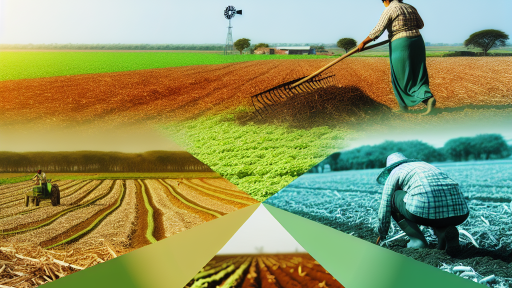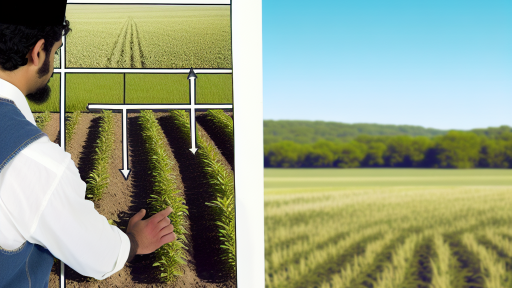Introduction to Sustainable Crop Rotation
Benefits of Sustainable Crop Rotation
Sustainable crop rotation offers numerous benefits for modern farmers.
First, it enhances soil health by improving its structure and fertility.
Moreover, crop rotation helps reduce soil erosion and nutrient depletion.
This practice also disrupts pest and disease cycles naturally.
As a result, farmers can minimize the need for chemical pesticides.
Additionally, diverse crops improve biodiversity on the farm.
This diverse ecosystem attracts beneficial insects and pollinators.
Furthermore, crop rotation can enhance crop yield over time.
Farmers experience increased resilience against climate variability.
These benefits contribute to more sustainable farming practices.
Importance of Implementing Crop Rotation
Implementing crop rotation is vital in today’s agricultural landscape.
It reduces dependency on chemical fertilizers by enhancing natural soil fertility.
This practice also promotes a circular economy within farming systems.
As a result, farmers can achieve greater economic sustainability.
Moreover, crop rotation helps in complying with environmental regulations.
Transform Your Agribusiness
Unlock your farm's potential with expert advice tailored to your needs. Get actionable steps that drive real results.
Get StartedIt plays a key role in reducing agricultural carbon footprints.
Importantly, healthy soil retains more water, improving drought resilience.
This strategy makes farms adaptable to changing climatic conditions.
Ultimately, crop rotation contributes to global food security.
Farmers who adopt this method are preparing for future challenges.
Key Principles of Crop Rotation
Diversity in Crop Selection
Diverse crop selection enhances soil health.
This practice reduces pest and disease cycles.
Additionally, it improves nutrient cycling in the soil.
Rotating different crops promotes biodiversity in farming systems.
Farmers should consider integrating legumes into their rotations.
Legumes fix nitrogen, enriching the soil naturally.
Timing the Rotation
Timing is crucial in crop rotation planning.
Farmers must consider seasonal patterns and local climate.
Specific planting and harvesting schedules enhance productivity.
Timing also helps mitigate disease and pest pressures.
Effective planning ensures optimal crop yields throughout the seasons.
Benefits of Using Legumes
Legumes offer multiple benefits in crop rotations.
They naturally enrich soil nitrogen levels.
This reduces the need for synthetic fertilizers.
Moreover, legumes improve soil structure and aeration.
They can also break soil compaction, enhancing water infiltration.
Incorporating legumes supports sustainable agriculture practices.
Choosing the Right Crops
Understanding Soil Health
The health of your soil directly impacts your crop yields.
A diverse crop rotation helps maintain soil fertility.
Showcase Your Farming Business
Publish your professional farming services profile on our blog for a one-time fee of $200 and reach a dedicated audience of farmers and agribusiness owners.
Publish Your ProfileIncorporate crops with varying nutrient needs.
This method enhances microbial activity in the soil.
Additionally, it reduces the risk of soil erosion.
Climate Compatibility
Select crops that thrive in your local climate.
Understanding seasonal weather patterns is crucial.
For example, certain legumes work well in warmer temperatures.
Consider drought-resistant varieties in arid regions.
Moreover, adapting your plan to climate change is vital.
Pest and Disease Management
Crop rotation disrupts pest and disease cycles effectively.
Introduce crops that are not hosts for specific pests.
This strategy lowers pesticide dependence over time.
In turn, it supports a healthier ecosystem on your farm.
Market Demand and Economics
Analyze market trends before finalizing your crop selection.
Choosing lucrative crops ensures profitability.
Furthermore, consider crops that meet local consumer preferences.
This approach helps reduce transportation costs.
Consequently, it strengthens your local economy.
Crop Nutrient Contribution
Different crops contribute various nutrients to the soil.
Legumes, for instance, fix nitrogen, benefiting future crops.
Utilize this natural fertilization to enhance productivity.
Additionally, some crops can help break soil compaction.
Incorporating cover crops also improves nutrient cycling.
See Related Content: Designing Farm Layouts for Optimal Water Use
Impact of Crop Rotation on Soil Health and Fertility
The Role of Nutrient Diversity
Crop rotation introduces a variety of nutrients into the soil.
This approach helps prevent nutrient depletion associated with monoculture.
Healthy soil contains adequate amounts of nitrogen, phosphorus, and potassium.
Different crops utilize these nutrients differently, enhancing soil fertility.
Enhancing Soil Structure
Crop rotation improves soil structure significantly.
Different root systems contribute to better soil aeration and drainage.
This aeration allows beneficial microorganisms to thrive in the soil.
Ultimately, improved structure helps prevent erosion and compaction.
Disease and Pest Management
Rotating crops reduces the buildup of pests and diseases.
Diverse plant families disrupt the life cycles of harmful organisms.
This method naturally reduces the need for chemical pesticides.
Farmers often observe healthier plants with fewer diseases.
Increasing Organic Matter
Crop rotation typically incorporates cover crops and legumes.
These plants enhance soil organic matter through biomass addition.
Increased organic matter leads to better moisture retention.
Furthermore, it boosts the soil’s overall biodiversity.
Long-Term Benefits for Sustainability
Sustainable farming relies on practices that support soil health.
Showcase Your Farming Business
Publish your professional farming services profile on our blog for a one-time fee of $200 and reach a dedicated audience of farmers and agribusiness owners.
Publish Your ProfileCrop rotation ensures the land remains productive over time.
It fosters resilience against climate-related challenges.
Consequently, farmers gain long-term economic benefits from healthier soils.
See Related Content: How Farmers Can Implement Carbon Sequestration
Managing Pests and Diseases
The Role of Crop Rotation
Crop rotation plays a vital role in sustainable agriculture.
It disrupts the lifecycle of pests and diseases.
This method reduces the need for chemical treatments.
Farmers can alternate crops that are less susceptible to specific pests.
Enhancing Soil Health
Diverse crops contribute to improved soil health.
Different root structures assist in nutrient distribution.
These practices help maintain soil structure and fertility.
Furthermore, healthy soil supports plant resilience against diseases.
Implementing Strategic Timing
Timing in planting can significantly affect pest populations.
Crops maturing at various times can confuse pests.
For example, rotating between fast and slow-growing crops prevents pest buildup.
This strategy disrupts their life cycles effectively.
Utilizing Companion Planting
Some farmers choose companion planting alongside rotation.
Companion plants can repel pests or attract beneficial insects.
For instance, planting marigolds can deter nematodes.
This approach complements crop rotation for better pest management.
Building Resilience through Diversity
A diverse crop rotation plan fosters resilience against diseases.
Disease-specific pathogens struggle to thrive in varied environments.
As a result, farmers can safeguard their yields more effectively.
Utilizing native crops can further enhance disease resistance.
You Might Also Like: Crop Rotation To Boost Soil Health Naturally
Examples of Effective Crop Rotation Plans for Various Climate Zones
Tropical Climate Rotation
Tropical farmers can benefit from diverse crop rotations.
In this climate, legumes, such as beans and peanuts, enhance soil nitrogen.
In addition, rotating with corn and sweet potatoes promotes soil health.
Farmers should aim for a four-year rotation cycle.
This cycle could include two years of legumes followed by corn and tubers.
Temperate Climate Rotation
In temperate regions, rotation strategies vary based on seasonal changes.
Farmers often plant cereals, followed by brassicas like cabbage or kale.
After that, root crops like carrots and beets can thrive.
This rotation improves soil structure and nutrient availability.
Consider implementing cover crops during off-seasons.
Arid Climate Rotation
Arid zones require specific strategies to maximize water usage.
Farmers should focus on drought-resistant crops.
For example, rotating sorghum with legumes ensures soil maintains moisture.
Utilizing cover crops can also prevent erosion during dry seasons.
This method enhances soil organic matter over time.
Showcase Your Farming Business
Publish your professional farming services profile on our blog for a one-time fee of $200 and reach a dedicated audience of farmers and agribusiness owners.
Publish Your ProfileCold Climate Rotation
Cold climates benefit from early-season and late-season crops.
Spring planting of peas can precede summer crops like corn.
In rotation, fall crops, such as winter wheat, can provide ground cover.
This technique prevents soil degradation during harsh winters.
Additionally, winter cover crops improve nutrient cycling.
General Tips for Crop Rotation
Farmers should always consider local soil types and conditions.
Monitoring pest and disease patterns is equally important.
Using diverse crops reduces pest susceptibility.
Furthermore, involving local agricultural extension services can provide additional insights.
Regular soil testing will ensure optimal crop health.
You Might Also Like: Crop Rotation and Carbon Sequestration Strategies

Technology and Tools for Implementing Crop Rotation
Utilizing Mobile Apps for Crop Management
Mobile applications simplify crop rotation planning for farmers.
Users can input climate, soil type, and crop details.
These apps provide tailored recommendations based on this data.
Moreover, they allow for monitoring crop health throughout the growing season.
For instance, FarmLogs helps farmers track their fields efficiently.
Another option, Agroop, focuses on water management and resource optimization.
Software Solutions for Crop Rotation Planning
Software programs offer comprehensive tools for farmers.
Farmers can analyze multiple crops and their benefits using crop simulation software.
They provide insights into yield predictions and risk assessments.
Programs like Croptracker help manage field activities and crop data.
Additionally, Agro Manager allows users to view historical crop performance.
Online Resources and Databases
Various online resources offer valuable insights into crop rotation.
Farmers can access extensive databases to understand crop compatibility.
Moreover, platforms like USDA’s plant database provide crucial information.
These resources help in selecting appropriate crops for rotation.
Furthermore, extension services often publish useful guides and articles.
Integrating IoT Devices for Precision Farming
Internet of Things (IoT) devices play a significant role in crop rotation.
Sensors can monitor soil conditions and moisture levels continuously.
This data helps farmers adjust their rotation plans effectively.
Moreover, drones can provide aerial views of crop health.
Thus, farmers can make informed decisions about replanting or diversifying crops.
Case Studies: Successful Sustainable Crop Rotation Implementations
Farm Fresh Co.
Farm Fresh Co. adopted a three-year rotation plan with corn, soybeans, and oats.
This method increased their soil health and crop yield significantly.
They observed a 30% reduction in pests after implementing this strategy.
Additionally, the practice improved nutrient cycling in the soil.
Green Valley Farms
Green Valley Farms showcases a diverse rotation system with legumes and cover crops.
They rotate sweet potatoes, beans, and wheat to enrich the soil.
This system has led to a 40% decrease in fertilizer use.
Moreover, crop diversity has reduced the risk of disease outbreaks.
Showcase Your Farming Business
Publish your professional farming services profile on our blog for a one-time fee of $200 and reach a dedicated audience of farmers and agribusiness owners.
Publish Your ProfileRiver Bend Agriculture
River Bend Agriculture implemented a four-crop rotation involving barley, peas, canola, and flax.
This diversified strategy has improved water retention in their fields.
They reported enhancing land resilience against extreme weather conditions.
Furthermore, they noted a boost in profit margins over the past five years.
Sunny Fields Organic Farm
Sunny Fields Organic Farm uses a unique rotation of tomatoes, squash, and peppers.
This approach has maintained high soil fertility without synthetic inputs.
They encourage beneficial insects by planting flowering species between crops.
The farm has gained recognition for its environmentally friendly practices.
Harvest Moon Growers
Harvest Moon Growers emphasizes seasonal planting cycles with diverse crops.
They have experienced a drastic increase in ecosystem services through crop rotations.
This includes improvements in pollination rates and soil health.
The farmers have shared their success model with local agricultural programs.
Challenges in Adopting Crop Rotation
Understanding the Barriers
Many farmers face significant challenges when adopting crop rotation.
First, there is a lack of knowledge about proper rotation techniques.
Furthermore, some farmers worry about the initial costs involved.
Additionally, time constraints can complicate planning and implementation.
Some farmers may also feel attached to traditional methods.
Overcoming Knowledge Gaps
Education plays a vital role in overcoming knowledge barriers.
Farmers can attend workshops and training sessions to learn more.
Partnerships with agricultural organizations can provide valuable resources.
Furthermore, farmers can utilize online platforms for continuous learning.
Addressing Financial Concerns
Financial assistance programs can help mitigate costs associated with crop rotation.
Farmers should explore grants and subsidies available in their regions.
Additionally, investing in crop rotation can lead to long-term savings.
As soil health improves, farmers may see increased yields over time.
Time Management Strategies
Efficient planning can help farmers manage time effectively.
Creating a detailed rotation schedule can streamline the process.
Collaboration with other farmers can also reduce individual workload.
Using technology tools can simplify tracking planting dates and crop growth.
Cultural and Traditional Factors
Addressing cultural barriers requires open discussions within farming communities.
Farmers can share success stories to encourage others to consider crop rotation.
Community events can highlight the benefits of sustainable practices.
Promoting peer support can help farmers feel more comfortable with change.
Additional Resources
Crop Rotation – Center for Regenerative Agriculture and Resilient …




